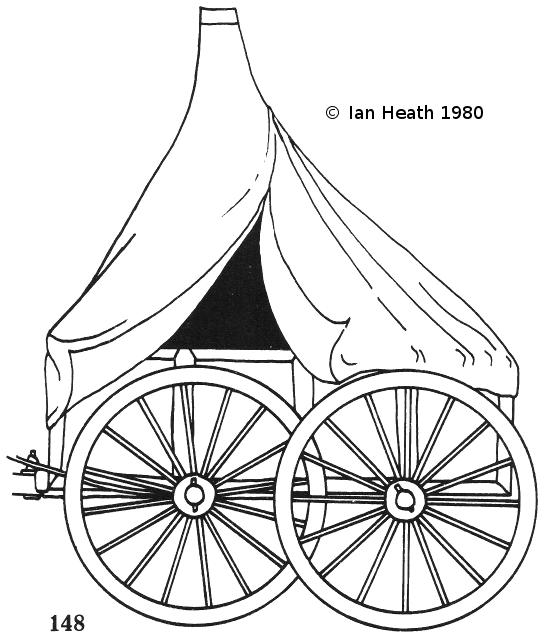Amazon Prime Student 6-month Trial

Shop Amazon - Create an Amazon Baby Registry
ASIATIC WAGON
An extract from Armies of the Dark Ages 600-1066
by Ian Heath

[Based on Cuman Wagons in the Radziwill Chronicle, Russia, 1490s. Library of the Russian Academy of Sciences, St Petersburg, (ban 34.5.30).]
147. ASIATIC WAGON
This is based chiefly on miniatures in the 15th century Radziwill ms., copied from a 13th century original.
Considerably earlier eastern sources show that there was little or no real change throughout this period.
Such wagons were either light and 2-wheeled or heavier with 4 wheels, and were normally drawn by 2-4 oxen, horses or even camels.
They were high-sided with tall, many-spoked wheels, and were reinforced with iron.
A Bulgar wagon of the 10th century is described as having sharp scythes on the wheels.
The erection of a tent in the back was standard practice.
These tents were removable and usually of felt or hide, though the tent of a Khazar Khagan’s command wagon recorded in the mid-8th century was of silk brocade surmounted by a pomegranate of gold and the wagon itself was spread with rich carpets.
The Pechenegs’ ‘large wagons in which were large loop-holes for shooting through’, recorded in their laager at the Battle of Eski Zagra in 1122,
may possibly indicate that the gaps between the wagons were filled with pavisses mounted on wheels or rollers as are known to have been used by the later Hussites and Cossacks.
In Radziwill the driver rides one of the draught horses, driving with rein and whip; a raised seat at the front of the wagon was probably more common.
Next: Bibliography in Armies of the Dark Ages 600-1066 by Ian Heath
Back to Extracts from and sources for illustrations in Armies of the Dark Ages 600-1066 by Ian Heath


